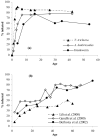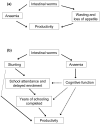Human hookworm infection in the 21st century
- PMID: 15603764
- PMCID: PMC2268732
- DOI: 10.1016/S0065-308X(04)58004-1
Human hookworm infection in the 21st century
Abstract
The scientific study of human hookworm infection began at the dawn of the twentieth century. In recent years, there have been dramatic improvements in our understanding of many aspects of this globally widespread parasite. This chapter reviews recent advances in our understanding in the biology, immunology, epidemiology, public health significance and control of hookworm, and to look forward to the study of this important parasite in the 21st century. Advances in molecular biology has lead to the identification of a variety of new molecules from hookworms, which have importance either in the molecular pathogenesis of hookworm infection or in the host-parasite relationship; some are also promising vaccine targets. At present, relatively little is known about the immune responses to hookworm infection, although it has recently been speculated that hookworm and other helminths may modulate specific immune responses to other pathogens and vaccines. Our epidemiological understanding of hookworm has improved through the development of mathematical models of transmission dynamics, which coupled with decades of field research across multiple epidemiological settings, have shown that certain population characteristics can now be recognised as common to the epidemiology, population biology and control of hookworm and other helminth species. Recent recognition of the subtle, but significant, impact of hookworm on health and education, together with the simplicity, safety, low cost and efficacy of chemotherapy has spurred international efforts to control the morbidity due to infection. Large-scale treatment programmes are currently underway, ideally supported by health education and integrated with the provision of improved water and sanitation. There are also on-going efforts to develop novel anthelmintic drugs and anti-hookworm vaccines.
Figures








References
-
- Albonico M. Methods to sustain drug efficacy in helminth control programmes. Acta Tropica. 2003;86:233–242. - PubMed
-
- Albonico M, Bickle Q, Ramsan M, Montresor A, Savioli L, Taylor M. Efficacy of mebendazole and levamisole alone or in combination against intestinal nematode infections after repeated targeted mebendazole treatment in Zanzibar. Bulletin of the World Health Organization. 2003;81:343–352. - PMC - PubMed
-
- Albonico M, Crompton DWT, Savioli L. Control strategies for human intestinal nematode infections. Advances in Parasitology. 1999;42:278–341. - PubMed
-
- Albonico M, Savioli L. Hookworm infection and disease: advances for control. Ann Ist Super Sanita. 1997;33:567–579. - PubMed
Publication types
MeSH terms
Grants and funding
LinkOut - more resources
Full Text Sources
Medical

